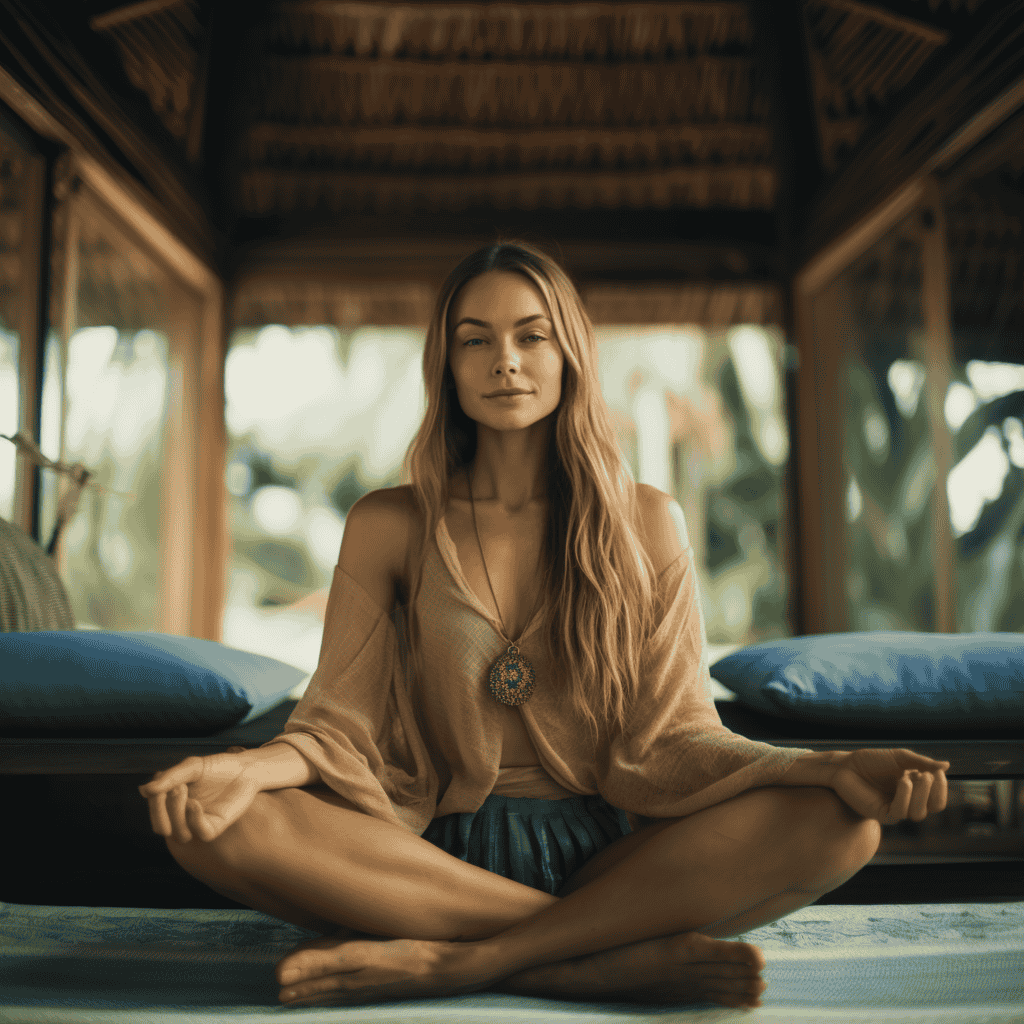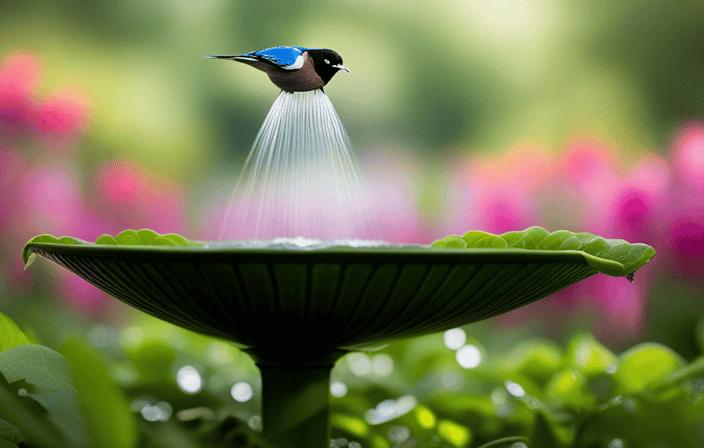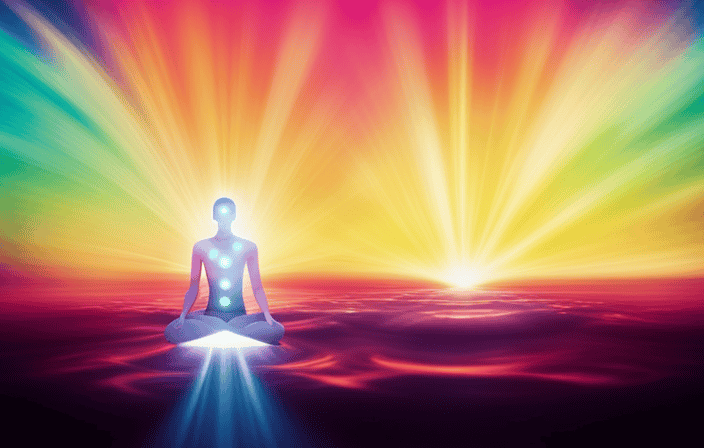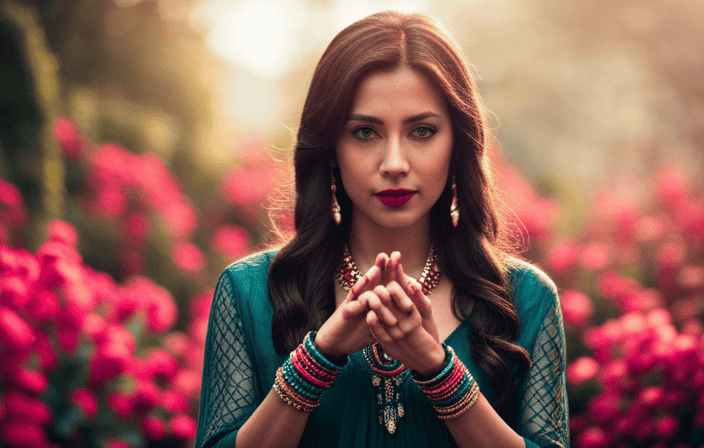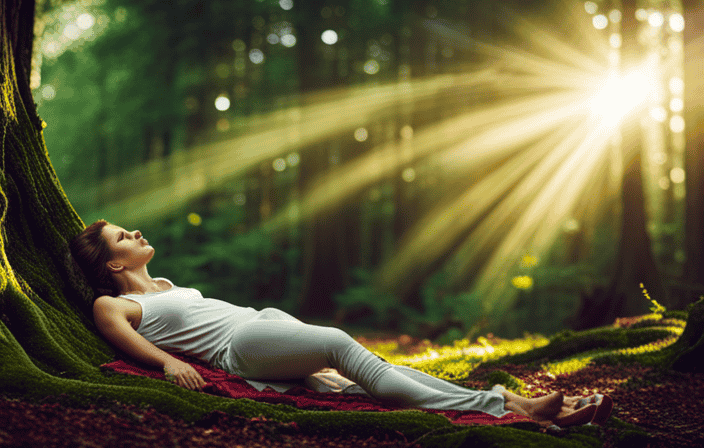Aura
Decoding Aura Colors: Unveiling The Meaningful Shades
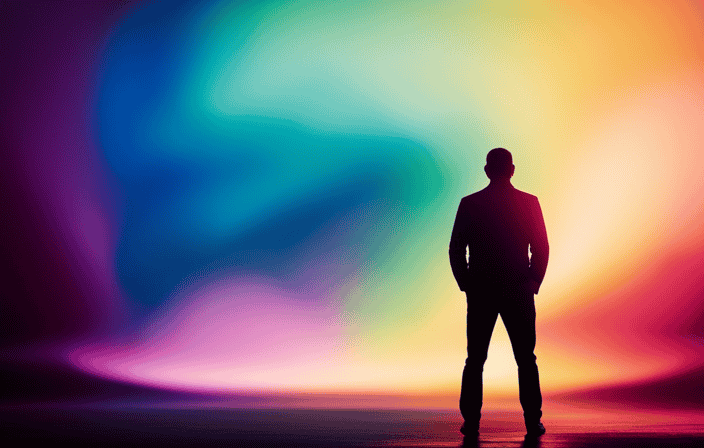
Deciphering the meanings behind aura colors can be compared to delving into the essence of one’s soul. Much like every stroke of paint on a canvas narrates a tale, the colors that radiate from us uncover concealed truths and feelings.
In this article, we delve into the captivating world of aura colors, deciphering their meanings and shedding light on the profound shades that make up our energetic essence.
Prepare to embark on a journey of discovery as we unravel the mysteries of decoding aura colors and unveil their meaningful shades.
Key Takeaways
- Aura reading techniques can interpret the emotional, physical, and spiritual states of a person’s aura.
- Each color in an aura holds a unique interpretation and significance, such as red for passion and energy, orange for social tendencies, and yellow for a sunny disposition or intellect.
- Combinations of colors in an aura reveal deeper emotional and spiritual states, and interpreting each color within the context of others is important.
- Understanding color intensity, contextual cues, personality traits, and the individual’s emotional, physical, and spiritual state are crucial for a comprehensive interpretation of an aura.
What is an Aura?
I know that an aura is the energy field surrounding a person’s body, which displays their emotional, physical, and spiritual states. It is believed that the aura holds significant information about a person’s well-being and can be interpreted through aura reading techniques.
The aura is composed of different colors, each carrying its own meaning. These colors vary from person to person and can change depending on the individual’s circumstances. Red, for example, signifies passion and energy, while orange indicates social tendencies. By understanding the significance of each color, one can gain insight into a person’s personality and current state of being.
It is important to interpret each hue within its context and consider other factors such as body language and facial expressions to accurately decode the aura’s colors and their meaningful shades.
Interpreting Aura Colors
Interpreting the colors in auras reveals valuable insights about emotional, physical, and spiritual states. Factors influencing aura interpretation include personality traits, contextual cues, and the combination of colors present.
To accurately read someone’s aura, it is important to consider each hue within its specific context. Techniques for aura reading involve combining the interpretation of each color present and avoiding assumptions of exclusively negative or positive meanings. Understanding the intensity of aura colors is also crucial.
Bright hues indicate strong emotions, while muted hues suggest calmness. Different shades of the same color represent varying intensity levels. To enhance accuracy, one should also take into account body language, facial expressions, and the environment in which the aura is observed.
By embracing these techniques, we can unlock the meaningful shades within someone’s aura and gain a deeper understanding of their energy.
Meanings of Colors
Exploring the various hues in auras offers valuable insights into the emotional, physical, and spiritual states of individuals. Aura color symbolism plays a significant role in understanding these states. Each color in an aura holds a unique interpretation and carries its own significance.
Red, for example, signifies passion and energy, while orange indicates social tendencies. Yellow represents a sunny disposition or intellect. It is important to consider the context and the combination of colors within an aura to accurately interpret its meaning. For instance, red and orange hues may signify strong endurance or resilience.
Understanding the significance of hues in an aura requires a comprehensive approach, considering the individual’s personality traits and contextual cues. By experiencing the technicolor intensity of someone’s energy, we gain a deeper understanding of their emotional and spiritual well-being.
Multiple Colors in Auras
Understanding the combination of colors within an aura allows for a more accurate interpretation of the individual’s emotional and spiritual states. Combinations of hues in an aura can reveal a deeper understanding of the person’s emotions and moods. By interpreting each color within the context of the others, we can uncover the emotional significance of the aura. For example, when red and orange hues are present together, it suggests strong endurance or resilience. It is important to consider personality traits and contextual cues when deciphering the meaning of multiple colors in an aura. To provide a clearer picture, here is a table that showcases some common combinations of colors and their potential interpretations:
| Combination of Colors | Emotional Significance |
|---|---|
| Red and Orange | Strong endurance or resilience |
| Blue and Green | Calmness and balance |
| Yellow and Purple | Spiritual growth and wisdom |
| Pink and Gold | Love and compassion |
By analyzing the different combinations of colors, we can gain a deeper understanding of an individual’s emotional and spiritual state.
Complete Understanding of Aura
To fully comprehend an aura, I combine the interpretation of each color and avoid making assumptions about whether the meanings are positive or negative.
It is important to understand that each person is unique, so our understanding should be comprehensive. Factors influencing aura interpretation include contextual cues and personality traits.
By considering these factors, we can gain a deeper understanding of the individual’s emotional, physical, and spiritual state.
It is crucial not to assume meanings based solely on the colors present in the aura. Instead, we should interpret each hue within its context for accuracy.
By experiencing the technicolor intensity of someone’s energy, we can unlock the meaningful shades of their aura and gain a more profound insight into their being.
Understanding Color Intensity
I can gauge the intensity of aura colors by observing the brightness or mutedness of the hues, as well as considering the various shades within each color. Bright hues suggest strong emotions, while muted hues indicate a sense of calmness.
By analyzing these visual cues, I can delve into the emotional significance behind each color. For example, a vibrant red may represent intense passion and energy, while a softer shade of red may indicate a more subdued form of these qualities. Similarly, different shades of the same color can reveal varying levels of intensity within a person’s aura.
To accurately interpret the intensity of aura colors, I also take into account body language, facial expressions, and the environment, which provide additional context for understanding someone’s emotional state.
Factors Influencing Aura Interpretation
When interpreting someone’s aura, it’s important to consider contextual factors that can influence the interpretation. Contextual cues and personality traits play a significant role in understanding the meaning behind the colors in an aura. Here are three key factors to consider:
-
Environment: The surroundings in which the person is in can impact their aura colors. For example, being in a peaceful and serene environment may result in softer and calmer hues, while a vibrant and energetic atmosphere can manifest in brighter and more intense colors.
-
Emotional state: The emotions a person is experiencing at the time can affect the colors in their aura. For instance, if someone is feeling joyful and content, their aura may display vibrant and warm tones, whereas feelings of sadness or anger may be reflected in darker or cooler shades.
-
Personality traits: Each individual has unique personality traits that can influence the colors in their aura. Introverted individuals may have softer and more subdued hues, while extroverted individuals may exhibit bold and vibrant colors.
By considering these contextual factors and taking into account the individual’s personality traits, a more accurate interpretation of their aura can be achieved.
Experiencing Someone’s Energy
Experiencing someone’s energy allows me to sense their vibrant presence and emotional state. Connecting with someone’s energy is like tapping into a whole new world of sensations and insights.
As I tune in, I am able to perceive the subtle vibrations of their aura, which is a reflection of their inner being. It’s fascinating to witness the kaleidoscope of colors that dance around them, each shade carrying its own meaning and significance.
Sensing aura vibrations requires a deep level of intuition and openness, as it goes beyond what meets the eye. It’s like immersing myself in a symphony of emotions, where each note represents a different aspect of their personality and experiences.
Through this connection, I gain a profound understanding of who they truly are, beyond what words can express.
Frequently Asked Questions
Can everyone see auras?
Aura visibility and perception vary among individuals. While some people possess the ability to see auras, it is not a universal skill. Factors such as innate sensitivity, spiritual development, and practice can influence one’s capacity to perceive auras.
Can aura colors change over time?
Yes, aura colors can change over time. The stability of aura colors depends on various factors such as emotional, physical, and spiritual states, as well as external influences and life events. These factors can cause shifts in aura colors.
Are there any negative meanings associated with certain aura colors?
Negative associations with certain aura colors can exist, but it’s important to consider cultural interpretations and avoid assuming exclusively positive or negative meanings. Each color has unique interpretations that should be understood comprehensively and within context.
Can auras be influenced by external factors?
Yes, auras can be influenced by external factors. Understanding the energy behind auras allows us to see how emotions, environments, and other external influences can impact the colors and intensity of someone’s aura.
Is there a scientific basis for the existence of auras?
Scientific research on auras has explored the existence of energy fields surrounding individuals. Aura photography captures these fields, displaying a colorful representation of one’s emotional, physical, and spiritual states.
Conclusion
In conclusion, decoding aura colors is a fascinating and intricate process. The shades within an aura hold profound meanings, revealing emotional, physical, and spiritual states. Each color has its own interpretation, offering insights into an individual’s personality and disposition.
The presence of multiple colors further enriches the aura’s complexity, reflecting a range of emotions and moods. To truly understand someone’s aura, one must consider the elements of each color and contextual factors. The intensity of aura colors also plays a significant role, conveying the strength of one’s emotions.
Decoding aura colors requires a deep understanding and appreciation of individual uniqueness and the power of energy. It is a captivating journey that unveils the meaningful shades within us, painting a vibrant portrait of our inner selves.
Meet Kiran, the guiding light of wisdom behind the empowering content at OurMindAndBody.com. As a talented and compassionate writer, Kiran weaves words with grace and insight, sharing profound knowledge and practical advice to inspire positive transformations in the lives of readers.
With a background in psychology and a deep-rooted passion for well-being, Kiran brings a unique blend of expertise and empathy to her writing. Her journey into the realm of mindfulness, meditation, and yoga began as a personal quest for self-discovery and healing. Having experienced the profound benefits of these practices firsthand, Kiran is committed to empowering others to embark on their own journeys of self-exploration and growth.
Aura
Turning Off Aura Frame: Tips And Troubleshooting
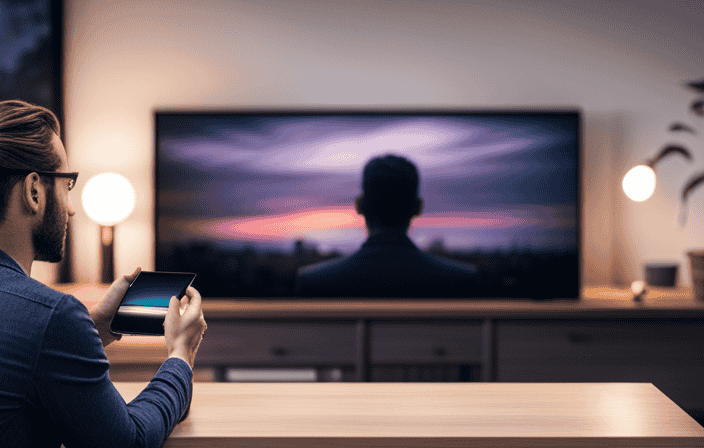
You may be enjoying the benefits of the Aura Frame, but there may be occasions when you need to turn it off. Whether it’s for improving system performance or reducing disruptions, I am here to help.
In this article, I’ll provide you with tips and troubleshooting techniques to successfully turn off Aura Frame. From accessing the settings to disabling Aura Frame and troubleshooting any issues you may encounter, I’ve got you covered.
Let’s dive in and get your Aura Frame turned off smoothly.
Key Takeaways
- Turning off Aura Frame can be done through the Aura icon in the taskbar or by accessing the settings.
- If Aura Frame is still visible after turning it off, restarting the computer or updating graphics card drivers may help.
- Accessing Aura Frame settings involves navigating through the Settings option on the home screen and selecting Device Management.
- Troubleshooting Aura Frame involves pressing any button to bring it back from sleep mode, adjusting settings for continuous visibility, and resetting the frame to factory settings if necessary.
Tips to Turn Off Aura Frame
To turn off Aura Frame, you can follow these tips and troubleshooting steps:
- Access the settings by clicking on the Aura icon in the taskbar and selecting Aura Frame.
- Toggle off the switch next to Enable Aura Frame.
If Aura Frame is still visible after this, try:
- Restarting your computer.
- Updating the graphics card drivers.
If you are unable to access the Aura Frame settings, you can reinstall Aura Sync.
It’s important to note that turning off Aura Frame improves system performance and reduces distractions. Remember that turning off Aura Frame does not turn off the device completely.
By following these tips, you can successfully turn off Aura Frame and enhance your system’s performance.
Accessing Aura Frame Settings
To access the settings for Aura Frame, follow these steps:
- Locate the Settings option on the home screen.
- Select General.
- Then, select Device Management.
- Finally, tap on Aura Frame.
Once you’re in the Aura Frame settings, you can toggle off the switch next to Enable Display to turn off Aura Frame. It’s important to note that turning off Aura Frame does not turn off the device completely.
If you encounter any issues with accessing the Aura Frame settings, ensure a stable Wi-Fi connection and check for firmware updates. Additionally, try restarting both the Aura Frame and the Wi-Fi router. If the problem persists, you can reset the frame by holding down the power button. As a last resort, download the latest version of the Aura app to troubleshoot the problem.
Disabling Aura Frame
I can disable Aura Frame by launching the Aura Sync application and selecting the device that I want to disable.
To do this, I start by opening the application and locating the device that I want to disable. Once I have selected the device, I tap on the Settings button.
From there, I look for the Aura Lighting Effect option and turn off the toggle switch to disable Aura Frame. This will effectively turn off the Aura Frame feature for the selected device.
It is important to note that disabling Aura Frame does not turn off the device completely, but it does stop the Aura Frame from being displayed.
By following these steps, I can easily disable Aura Frame and customize my device’s lighting effects according to my preferences.
Troubleshooting Aura Frame
If the Aura Frame is still visible, pressing any button can bring it back from sleep mode.
In order to display photos continuously, I can adjust the settings of the frame.
If the frame is still not functioning properly, I have the option to reset it to its factory settings by holding down the reset button.
Another troubleshooting step I can take is to manually update the device through a USB drive if a software glitch occurs.
In order to ensure that I can access the Aura Frame settings, I should make sure that I have a stable Wi-Fi connection and check for any firmware updates.
If the issue persists, I can try restarting both the Aura Frame and the Wi-Fi router.
Finally, downloading the latest version of the Aura app may also help resolve any problems.
Frame Still Visible
Pressing any button on the Aura Frame can bring it back from sleep mode if it is still visible. If your Aura Frame is not displaying photos continuously, you can adjust the settings to ensure that it stays visible.
Simply go to the Settings option on the Aura Frame’s home screen, select General, and then choose Device Management. From there, tap on Aura Frame to access its settings. Toggle off the switch next to Enable Display to turn off Aura Frame.
If the frame is still visible and you need to reset it, you can do so by holding down the reset button to restore it to factory settings.
Additionally, if you encounter a software glitch, you can manually update the device through a USB drive.
Unable to Access Settings
To access the Aura Frame settings, make sure you have a stable Wi-Fi connection and check for any firmware updates.
If you’re still unable to access the settings, try restarting both the Aura Frame and your Wi-Fi router.
If the issue persists, you can try resetting the Frame by holding down the power button.
Another solution is to download the latest version of the Aura app, as this may resolve any compatibility issues.
It’s important to ensure that your Wi-Fi connection is stable, as a weak connection can affect the accessibility of the settings.
Additionally, checking for firmware updates is crucial, as these updates often include bug fixes and improvements that can address any problems with accessing the Aura Frame settings.
I can access the Aura Frame settings by selecting the General option and then choosing Device Management. From there, I can tap on the Aura Frame to access its settings.
Once I’m in the settings, I can toggle off the switch next to Enable Display to turn off Aura Frame. It’s important to note that turning off Aura Frame does not turn off the device completely.
If I’m still unable to access the Aura Frame settings, there are a few troubleshooting steps I can take.
First, I should ensure a stable Wi-Fi connection and check for any firmware updates. If the issue persists, I can try restarting both the Aura Frame and my Wi-Fi router.
If all else fails, I may need to reset the frame by holding down the power button or download the latest version of the Aura app.
If you cannot access the Aura Frame settings, there are troubleshooting steps you can take. First, ensure a stable Wi-Fi connection by checking if your device is connected to a reliable network. Weak or unstable connections may prevent access to the Aura Frame settings.
Next, check for firmware updates. Make sure your Aura Frame has the latest firmware version installed. Firmware updates often include bug fixes and improvements that can resolve issues with accessing settings.
If the problem persists, try restarting both the Aura Frame and your Wi-Fi router. Sometimes, a simple restart can fix connectivity issues. Turn off your Aura Frame and then power it back on. Additionally, restart your Wi-Fi router to refresh the connection.
By following these troubleshooting steps, you should be able to access the Aura Frame settings and make the necessary adjustments.
Frequently Asked Questions
How do I turn off Aura Frame without accessing the settings?
To turn off Aura Frame without accessing the settings, simply press and hold the power button for a few seconds until the device turns off. This will effectively disable the Aura Frame without accessing any settings.
Will turning off Aura Frame affect the functionality of other Aura Sync devices?
Turning off Aura Frame will not affect the functionality of other Aura Sync devices. Each device can be controlled independently, so disabling Aura Frame will only turn off the frame display and not impact other devices.
Can I still use the Aura Sync features while Aura Frame is turned off?
Yes, you can still use the Aura Sync features while Aura Frame is turned off. Turning off Aura Frame only disables the display function of the frame, but it does not affect the functionality of other Aura Sync devices.
How can I customize the display settings of Aura Frame?
To customize the display settings of Aura Frame, access the Aura Frame settings through the General section of the Settings option on the home screen. From there, you can toggle off the Enable Display switch to turn off Aura Frame.
Is there a way to schedule when Aura Frame turns on and off?
Yes, you can schedule when the Aura Frame turns on and off. Simply access the settings of the Aura Frame and look for the option to set a schedule. From there, you can choose specific times for the frame to turn on and off automatically.
Conclusion
In conclusion, turning off Aura Frame can be done through various methods. These include accessing the settings in the taskbar or through the Aura Sync application.
Troubleshooting tips for Aura Frame include bringing the frame back from sleep mode, adjusting settings for continuous photo display, and manually updating the device.
One interesting statistic is that updating the graphics card drivers can help if the Aura Frame is still visible after restarting the computer.
With these tips and troubleshooting steps, users can effectively turn off Aura Frame and enhance their system performance.
Meet Nadi, the soulful writer and explorer of inner realms who graces OurMindAndBody.com with her profound insights and heartfelt wisdom. With a profound passion for mindfulness, meditation, and spiritual growth, Nadi weaves words that touch the hearts and minds of readers, leaving a lasting impact on their well-being journey.
Rooted in a background of philosophy and psychology, Nadi’s curiosity about the human mind and the mysteries of the soul led her on a transformative path of self-discovery. Drawn to the transformative power of mindfulness and meditation, she embarked on a quest to understand the intricacies of these practices, not only for her own growth but also to inspire others to embark on their own inner journeys.
Aura
The Spiritual Significance Of Stray Cat Visits: Protection, Independence, And Intuition

Have you ever noticed the quiet, yet impactful, appearance of a stray cat at your home? It’s as if the universe has sent a gentle messenger, filled with the gifts of protection, independence, and wisdom.
These feline visitors, with their mysterious allure, hold a spiritual significance that transcends the physical realm. In this article, we will explore the hidden meanings behind stray cat visits, uncovering the wisdom and blessings they bring to our lives.
So, let us embark on a journey of self-discovery and spiritual connection, as we delve into the intriguing world of the stray cat’s presence.
Key Takeaways
- Stray cat visits symbolize protection, freedom, independence, and spiritual growth.
- Welcoming stray cats with food, water, and shelter represents the interconnection between beings and can bring good luck, prosperity, healing energy, and positive vibes.
- Stray cat visits indicate the need to pay attention to intuition and inner wisdom and can be a sign of a spiritual connection.
- Providing food and shelter to stray cats can bring purpose and fulfillment.
What Does It Mean?
When a stray cat comes to my house, its spiritual meaning is that it symbolizes protection, independence, and the need to pay attention to my intuition. It is a subtle reminder that I am never alone and that I am protected by unseen forces.
The presence of a stray cat signifies that I have the strength and independence to navigate through life’s challenges on my own. It encourages me to trust in my own abilities and instincts.
This visit also serves as a gentle nudge to listen to my inner voice, to trust my intuition, and to follow the path that resonates with my true self. The stray cat’s presence is a reminder that I have the power to create my own destiny and that I am capable of finding my own way in life.
Symbolizes and Represents
Symbolizes and represents the presence of a guardian and the ability to trust one’s instincts and inner wisdom.
When a stray cat visits your house, it is a spiritual reminder that you are protected and supported.
The cat’s independent nature symbolizes your own need for freedom and self-reliance. It encourages you to embrace your independence and follow your own path.
The stray cat’s presence also signifies the importance of intuition and inner wisdom. It reminds you to trust your instincts and listen to the messages from your higher self.
By providing food, water, and shelter to the stray cat, you are fulfilling a spiritual purpose and finding fulfillment in helping others.
This connection between beings reinforces the interconnection of all living things and the power of compassion and kindness.
Welcoming and Interconnection
By welcoming a stray cat into my home, I am fostering a sense of interconnection and compassion towards all living beings. It is a beautiful reminder that we are all interconnected in this vast universe. As I provide food, water, and shelter for the stray cat, I am also nourishing my own soul with love and kindness.
The soft purring of the cat reverberates in the stillness of my home, creating a peaceful and serene atmosphere. Watching the graceful movements of the cat as it explores its new surroundings fills me with awe and reminds me of the beauty of independence.
The gentle nudge of the cat against my leg brings a sense of comfort and reassurance, reminding me that I am not alone in this journey of life. As I observe the cat’s keen instincts and ability to trust its intuition, I am inspired to pay closer attention to my own inner wisdom.
The presence of the stray cat brings a sense of purpose and fulfillment, reminding me of the joy that comes from helping and nurturing others.
In welcoming a stray cat, I not only provide it with a safe haven but also open myself up to the profound spiritual lessons it has to offer.
Associated with Goddesses
As I learn about the spiritual meaning of stray cat visits, I discover that they are often associated with goddesses and bring good luck and positive vibes. It is fascinating to delve into the ancient connections between cats and divine feminine energy.
Cats have long been revered as sacred animals, embodying grace, mystery, and independence. In many cultures, they are linked to goddesses such as Bastet, Freyja, and Artemis. These goddesses represent protection, fertility, and wisdom.
When a stray cat comes to our house, it is a reminder of the divine feminine energy within us and the need to nurture and honor our intuition. By welcoming these feline visitors with open hearts and providing them with food and shelter, we not only invite good fortune and prosperity into our lives but also experience a deeper spiritual connection with the universe.
Bringing Good Luck and Prosperity
When a stray cat comes to my house, it brings good luck and prosperity into my life. It is as if this feline visitor carries with it a sense of abundance and positive energy.
I believe that the presence of a stray cat symbolizes the universe’s way of showering me with blessings and opportunities. It reminds me to be open to receiving good fortune and to embrace the abundance that surrounds me.
This unexpected visitor serves as a gentle reminder that even in the midst of uncertainty and unpredictability, there is always the potential for growth and prosperity. I am grateful for the spiritual connection that I feel with these stray cats, as they remind me to trust my intuition and follow the path that leads to my highest good.
Paying Attention to Intuition
Paying attention to my gut feelings and inner wisdom has become even more important since the stray cat started visiting my house. It’s as if this feline visitor serves as a constant reminder to trust my intuition and listen to the whispers of my soul.
As I observe the cat’s independent nature and ability to navigate through life with grace, I am inspired to do the same. There is a profound connection between us, a reminder of the interconnection between all beings.
This stray cat brings a sense of purpose and fulfillment as I provide it with food and shelter, and in return, it brings me healing energy and positive vibes. It is through this spiritual connection that I am reminded of the power of my own intuition and the wisdom that lies within.
Sign of Connection
Experiencing a deep connection with the stray cat that visits my house serves as a powerful reminder of the interwoven nature of all beings.
As I observe this cat’s presence, I am reminded of the spiritual significance it carries. It symbolizes a profound connection, not only with the cat itself but with the universe as a whole. This connection encourages me to pay attention to my intuition and inner wisdom, as the cat’s presence signifies the need for spiritual growth.
Through its visits, the stray cat brings a sense of protection and independence, reminding me to embrace these qualities in my own life. I am grateful for the opportunity to provide food and shelter, as it brings purpose and fulfillment, knowing that I am contributing to the well-being of another being.
This connection with the stray cat is a gentle reminder that we are all interconnected in this vast universe, and it is through these connections that we find meaning and fulfillment in our lives.
Providing Purpose and Fulfillment
Providing food and shelter to the stray cat that visits my house brings a sense of purpose and fulfillment to my life. It is a small act of kindness that makes a big difference not only for the cat but also for myself. Taking care of this stray cat gives me a sense of responsibility and a feeling of being needed. It reminds me that even the smallest acts of compassion can have a profound impact on someone’s life, whether they are human or animal. It also reinforces the understanding that we are all interconnected beings, and by providing for this cat, I am contributing to the well-being of the larger universe. This simple act of nourishment and shelter allows me to tap into my own intuition and inner wisdom, as I am reminded of the importance of listening to and caring for the needs of others.
| Providing Purpose and Fulfillment | |
|---|---|
| – Sense of responsibility | – Feeling needed |
| – Small acts of kindness make a big difference | – Contributing to the well-being of the universe |
| – Reinforces interconnection between beings | – Tapping into intuition and inner wisdom |
| – Nourishing and sheltering others brings purpose | – Reminds us to care for the needs of others |
Frequently Asked Questions
Can stray cat visits also symbolize loneliness or a need for companionship?
Yes, stray cat visits can also symbolize loneliness or a need for companionship. Their presence may be a reminder to seek connection with others and to fulfill our emotional needs.
How can one differentiate between a stray cat and a feral cat?
Differentiating between a stray cat and a feral cat is like discerning between a lost soul searching for connection and a wild spirit untamed by society. Both yearn for compassion, but only one craves companionship.
Are there any specific spiritual rituals or practices that can be done to attract positive energy through stray cat visits?
To attract positive energy through stray cat visits, I focus on creating a loving and welcoming environment. I offer food, water, and shelter, and I embrace the interconnection between beings. This practice brings purpose, fulfillment, and a deeper spiritual connection.
Is it possible for a stray cat to bring negative energy or bad luck if it is not welcomed or cared for properly?
If a stray cat is not welcomed or cared for properly, it is unlikely to bring negative energy or bad luck. However, neglecting its needs may hinder the potential positive energy and spiritual growth it could bring.
Are there any specific signs or behaviors that indicate a stray cat is trying to communicate a message or guidance?
When a stray cat is trying to communicate a message or guidance, it may exhibit unique behaviors such as persistent meowing, following you closely, or bringing you small gifts. These signs indicate a deeper spiritual connection and the cat’s desire to guide and protect you.
Conclusion
In conclusion, the spiritual significance of stray cat visits is truly fascinating.
These visits symbolize protection, independence, and intuition, reminding us of the importance of creating a safe and comfortable environment for these beautiful creatures.
By welcoming them and providing food, water, and shelter, we not only reflect the interconnectedness between beings but also invite good luck, prosperity, and healing energy into our lives.
It is remarkable to note that providing food and shelter to stray cats can bring purpose and fulfillment.
So next time a stray cat visits, embrace the opportunity to connect with the spiritual realm and experience the positive vibes it brings.
After all, statistics show that those who provide care to stray cats often experience a sense of purpose and fulfillment in their lives, making it a truly rewarding experience.
Meet Nadi, the soulful writer and explorer of inner realms who graces OurMindAndBody.com with her profound insights and heartfelt wisdom. With a profound passion for mindfulness, meditation, and spiritual growth, Nadi weaves words that touch the hearts and minds of readers, leaving a lasting impact on their well-being journey.
Rooted in a background of philosophy and psychology, Nadi’s curiosity about the human mind and the mysteries of the soul led her on a transformative path of self-discovery. Drawn to the transformative power of mindfulness and meditation, she embarked on a quest to understand the intricacies of these practices, not only for her own growth but also to inspire others to embark on their own inner journeys.
Aura
The Vibrant Yellow Aura: Creativity, Optimism, And Communication
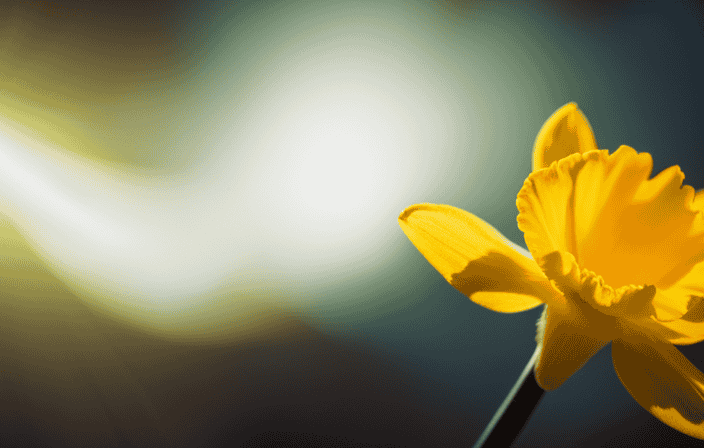
Did you know that individuals with a bright yellow aura are not only extremely creative but also incredibly positive and excellent communicators? This fascinating fact emphasizes the strong influence that the color yellow has on our personality traits and overall well-being.
In this article, we will explore the characteristics and manifestations of a yellow aura, delve into how it impacts our personal lives and productivity, and discover effective practices, such as yoga and active listening, to enhance its positive effects.
So, if you’re ready to embrace your inner creativity, optimism, and communication skills, let’s dive into the world of the vibrant yellow aura.
Key Takeaways
- The vibrant yellow aura represents creativity, optimism, and intelligence.
- A yellow aura indicates good communication skills and a strong sense of self.
- Individuals with a yellow aura are attracted to fields such as teaching, writing, and art.
- The emotional state influences the shades of yellow in the aura, with a vibrant yellow indicating confidence, joyfulness, creativity, and curiosity, while a pale or dull yellow may indicate caution, insecurity, or anxiety.
What Does it Signify?
I’m a yellow aura individual, and when it comes to the vibrant yellow aura, it signifies creativity, optimism, and excellent communication skills.
As someone with a yellow aura, I have always felt a deep connection to my creative side. It allows me to express myself freely and brings a sense of joy and fulfillment to my life.
Optimism is another key characteristic of a yellow aura, and it has helped me navigate through life’s challenges with a positive outlook. It enables me to see the silver lining in every situation and find solutions even in the face of adversity.
Lastly, my yellow aura gives me the gift of excellent communication skills. I can easily connect with others, express my thoughts and ideas effectively, and inspire those around me.
It’s a beautiful aura to have, and I’m grateful for the creativity, optimism, and communication skills it brings into my life.
Characteristics and Manifestations
Radiating a bright beam of sunshine, my energy exudes a radiant glow that inspires others and ignites their passions. My vibrant yellow aura signifies a combination of creativity, optimism, and communication skills. With my strong sense of self and good communication abilities, I am naturally drawn to fields such as teaching, writing, and art.
My curiosity and joyfulness fuel my creativity, allowing me to express myself in unique and innovative ways. However, I am not immune to anxiety or stress, as my pale or dull yellow aura may indicate. To maintain my emotional well-being, I strive for a harmonious balance by engaging in self-reflection and spiritual practices. Spending time in nature uplifts my mood and reduces stress levels.
I understand the importance of positive relationships, empathy, and forgiveness in promoting my overall well-being. By embracing challenges and stepping out of my comfort zone, I continuously enhance my personal and professional growth. Yoga and active listening play crucial roles in enhancing the positive effects of my yellow aura. Yoga strengthens my mind-body connection and promotes spiritual awakening, while active listening fosters healthy relationships and improves my communication skills.
With my optimistic outlook on life, impeccable sense of humor, and outgoing nature, I thrive in creative professions that require excellent communication skills. Whether it be teaching, writing, or inspiring others through my charisma, I am always seeking opportunities to express my ideas and make a positive impact on those around me.
Personal Life and Well-being
Balancing personal relationships and adapting to changes, I engage in social activities and share my experiences and knowledge. I find immense joy in connecting with others and learning from their unique perspectives.
Being a vibrant yellow aura individual, I possess an optimistic outlook towards life, which allows me to see opportunities even in the face of challenges. I thrive on exploring new things, whether it’s traveling to unfamiliar places or delving into new areas of knowledge.
However, I also understand the importance of maintaining a harmonious balance in my spiritual and emotional well-being. This requires me to effectively cope with stress and manage my emotions. I find that positive relationships, empathy, and forgiveness play a crucial role in promoting my overall well-being.
Moreover, I constantly engage in self-reflection and spiritual practices to ensure a sense of balance within myself. Spending time in nature uplifts my mood and reduces stress levels, allowing me to approach life with renewed energy and curiosity.
Enhancing Productivity
Exploring unconventional approaches and pushing beyond limits has transformed failures into valuable learning opportunities, enhancing my problem-solving skills and personal growth. It has allowed me to think outside the box and find innovative solutions to challenges. Stepping out of my comfort zone has been daunting at times, but it has also been incredibly rewarding. Embracing failure as a stepping stone to success has taught me resilience and perseverance.
This journey has been filled with ups and downs, but each setback has only fueled my determination to succeed. It has taught me the importance of embracing change and adapting to new situations. Through this process, I have discovered my own strengths and weaknesses, and have learned to harness my creativity and optimism to overcome obstacles.
In the face of adversity, I have learned to remain positive and maintain my motivation. I have realized that my vibrant yellow aura is not just a representation of my creativity and communication skills, but also a symbol of my resilience and ability to find joy in the face of challenges.
- Embracing failure as an opportunity for growth
- Finding inspiration in unexpected places
- Pushing beyond self-imposed limitations
- Embracing change and adapting to new situations
- Maintaining a positive mindset in the face of adversity
Yoga and Active Listening
Practicing yoga and actively listening have greatly enhanced my well-being and personal growth. Yoga has strengthened my mind-body connection and promoted spiritual awakening. It has helped me channelize restlessness and anxiety constructively, improving my focus, creativity, and overall well-being. Incorporating yoga into my daily routine has been a transformative experience.
Additionally, actively listening has fostered healthy relationships essential for my personal growth. It has enhanced my understanding and empathy towards others, building trust and strengthening connections. Through active listening, I have improved my communication skills and gained better conflict resolution abilities. It has allowed me to truly connect with others, fostering compassion and promoting a sense of unity.
To illustrate the benefits of yoga and active listening, here is a table highlighting their positive effects:
| Yoga | Active Listening |
|---|---|
| Strengthens mind-body connection | Fosters healthy relationships |
| Promotes spiritual awakening | Enhances understanding and empathy |
| Improves focus, creativity, and well-being | Builds trust and strengthens connections |
By incorporating these practices into my life, I have found a deeper sense of self-awareness and personal growth. They have been instrumental in cultivating a vibrant yellow aura, fostering creativity, optimism, and effective communication.
Professions and Positive Traits
Engaging in creative professions such as teaching, music, art, and writing allows me to express my ideas and use my excellent communication skills to inspire and motivate others, fostering personal and professional growth.
As someone with a vibrant yellow aura, I thrive in roles that allow me to utilize my creativity, optimism, and outgoing nature. Teaching, for example, provides me with the opportunity to share my knowledge and experiences, while also encouraging curiosity and a love for learning in others.
Similarly, working in the field of art or writing allows me to express my inner thoughts and emotions, while connecting with others on a deeper level. Through these professions, I can truly make a positive impact and contribute to the growth and development of those around me.
Colors and Emotional State
When I’m feeling joyful and confident, my aura takes on a vibrant shade that reflects my positive emotional state. The brilliant yellow hues radiate with creativity, optimism, and a zest for life. It’s as if the vibrant energy within me bursts forth, attracting others with its magnetic charm.
In this state, I find myself fully engaged in the world, seeking out new experiences and sharing my knowledge and ideas with others. My communication skills are at their peak, effortlessly connecting with those around me.
This radiant yellow aura not only inspires and motivates others, but it also fuels my own sense of purpose and fulfillment. It reminds me to embrace the joyfulness of life, to pursue my passions with unwavering enthusiasm, and to always approach challenges with a curious and creative mind.
Maintaining Balance
Maintaining a harmonious balance in my life requires self-reflection and a commitment to spiritual practices. But what if I neglect these essential aspects of my well-being? It’s easy to get caught up in the hustle and bustle of daily life, forgetting to take a step back and prioritize my emotional and spiritual needs.
However, I have come to realize that neglecting self-care can lead to feelings of imbalance and unrest.
To ensure that I maintain equilibrium, I have learned the importance of self-reflection and spiritual practices. These practices allow me to reconnect with myself, understand my emotions, and find inner peace. Additionally, spending time in nature uplifts my mood and reduces stress levels, contributing to a sense of balance.
In order to further enhance my well-being, I prioritize positive relationships, empathy, and forgiveness. These qualities promote a healthy emotional state and contribute to a harmonious life. By cultivating self-awareness and engaging in spiritual practices, I am able to navigate life’s challenges with a sense of calm and resilience.
Improving Relationships
Maintaining balance in my personal life and well-being has always been a priority for me as someone with a vibrant yellow aura.
However, I have come to realize that nurturing positive relationships is just as crucial. Improving relationships requires active listening and a genuine effort to understand and empathize with others.
By practicing active listening, I have learned to truly hear and validate the feelings and experiences of those around me. This fosters trust, strengthens connections, and enhances communication skills.
Conflict resolution becomes easier when there is a foundation of empathy and understanding. I have discovered that building positive relationships not only promotes personal growth but also brings immense joy and fulfillment.
It is through these connections that I continue to thrive, inspire, and motivate others, allowing my vibrant yellow aura to shine even brighter.
Spiritual Practices
Engaging in spiritual practices has been essential in maintaining a harmonious balance in my personal and emotional well-being. These practices have allowed me to delve deeper into my inner self, connecting with a higher power and finding solace in the midst of life’s challenges.
Through meditation, I have discovered a sense of peace and clarity that helps me navigate through the ups and downs of life. Journaling has become a sacred ritual, allowing me to reflect on my thoughts and emotions, gaining a deeper understanding of myself.
I have also found solace in nature, spending time outdoors and immersing myself in its beauty and serenity. Lastly, practicing gratitude has shifted my perspective, reminding me of the abundance and blessings that surround me.
These spiritual practices have not only enhanced my well-being but have also allowed me to cultivate a deeper connection with others and the world around me.
Incorporating Yoga
Incorporating yoga into my daily routine has been a transformative practice for enhancing my overall well-being. It has allowed me to strengthen the mind-body connection and embark on a spiritual awakening. Yoga helps me channelize restlessness and anxiety constructively, bringing a sense of calm and tranquility to my life.
Through yoga, I have improved my focus, creativity, and overall well-being. It has taught me to be present in the moment and let go of the stresses of daily life. The practice of active listening, which I have also embraced, has fostered compassion and understanding towards others. It has strengthened my relationships, improved my communication skills, and enhanced my conflict resolution abilities.
Below is a visual representation of how incorporating yoga and active listening into my life has positively impacted my well-being:
| Yoga | Active Listening |
|---|---|
| Strengthens mind-body connection | Fosters healthy relationships |
| Promotes spiritual awakening | Enhances understanding and empathy |
| Improves focus and creativity | Builds trust and strengthens connections |
| Reduces stress levels | Improves communication and conflict resolution skills |
Overall, incorporating yoga and active listening into my daily routine has brought about a sense of balance, harmony, and personal growth in my life.
Frequently Asked Questions
How can a yellow aura affect relationships with others?
A yellow aura affects relationships by radiating positivity and good communication skills. It creates a vibrant energy that attracts and inspires others. With my yellow aura, I strive to build strong connections and foster understanding and empathy.
What are some common challenges faced by individuals with a yellow aura?
Some common challenges faced by individuals with a yellow aura include managing anxiety and stress, finding a harmonious balance in relationships, and coping with failure. However, these challenges can also lead to personal and professional growth.
Can the shade of yellow in a person’s aura change over time?
Yes, the shade of yellow in a person’s aura can change over time. It reflects our emotional state and can be influenced by various factors. It is important to nurture our well-being to maintain a vibrant and positive aura.
How can someone with a yellow aura effectively manage stress and anxiety?
To effectively manage stress and anxiety as someone with a yellow aura, I prioritize self-care and engage in activities that promote balance, such as spending time in nature, practicing mindfulness, and cultivating positive relationships.
Are there any specific meditation techniques or practices that can enhance the vibrancy of a yellow aura?
To enhance the vibrancy of a yellow aura, I find that incorporating meditation techniques such as visualization, deep breathing, and positive affirmations can be beneficial. These practices help me cultivate a sense of calm, clarity, and inner joy.
Conclusion
In conclusion, discovering the vibrant yellow aura has been truly eye-opening. It has allowed me to understand the immense power of creativity, optimism, and communication in shaping our lives.
Through embracing my yellow aura, I have learned to approach challenges with curiosity and confidence, embracing failure as an opportunity for growth. Yoga and active listening have become my daily practices, allowing me to enhance my productivity and problem-solving skills.
By maintaining balance and nurturing my relationships, I have found a deeper sense of joy and fulfillment. Incorporating spiritual practices has added a profound dimension to my journey, guiding me towards a greater understanding of myself and the world around me.
The vibrant yellow aura has not only transformed my personal and professional life but has also ignited a passion within me to share my experiences and knowledge with others. Coincidentally, as I embrace my yellow aura, I find myself surrounded by individuals who share the same zest for life and the desire to make a positive impact.
Together, we create a vibrant community that fosters growth, inspiration, and connection. It is my hope that more individuals will explore and embrace their unique aura, allowing it to guide them towards a life filled with creativity, optimism, and meaningful communication.
Meet Nadi, the soulful writer and explorer of inner realms who graces OurMindAndBody.com with her profound insights and heartfelt wisdom. With a profound passion for mindfulness, meditation, and spiritual growth, Nadi weaves words that touch the hearts and minds of readers, leaving a lasting impact on their well-being journey.
Rooted in a background of philosophy and psychology, Nadi’s curiosity about the human mind and the mysteries of the soul led her on a transformative path of self-discovery. Drawn to the transformative power of mindfulness and meditation, she embarked on a quest to understand the intricacies of these practices, not only for her own growth but also to inspire others to embark on their own inner journeys.
-

 Meditation1 month ago
Meditation1 month agoUnderstanding Spiritual Attacks: Types, Signs, And Protection
-

 Personal Growth3 months ago
Personal Growth3 months agoThe Power Of Kindness: Cultivating Happiness, Connection, And Personal Growth
-
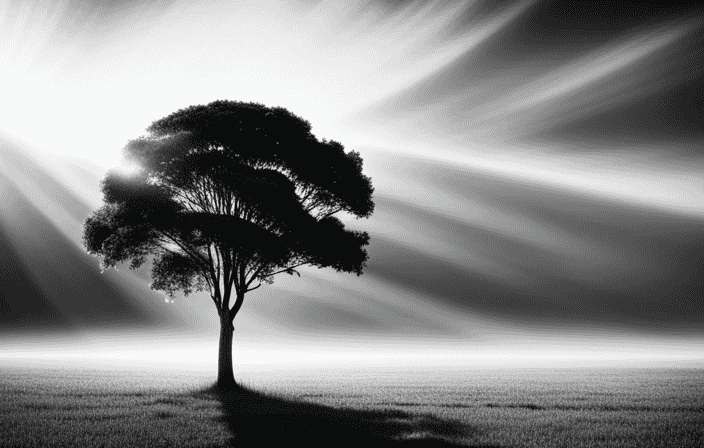
 Aura2 months ago
Aura2 months agoUnderstanding The Grey Aura: Balance, Neutrality, And Personal Growth
-

 Meditation2 months ago
Meditation2 months agoThe Symbolic Significance Of Sand Dollar: Spiritual Meanings And Cultural Connections
-
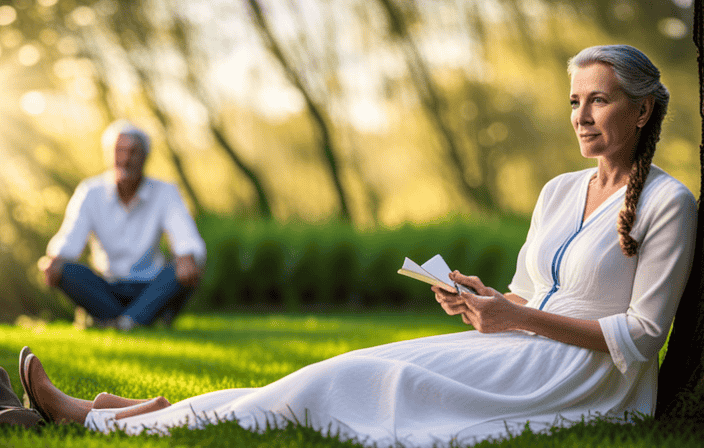
 Inspiration3 months ago
Inspiration3 months agoThe Role And Qualities Of A Spiritual Advisor: A Guide On The Path
-
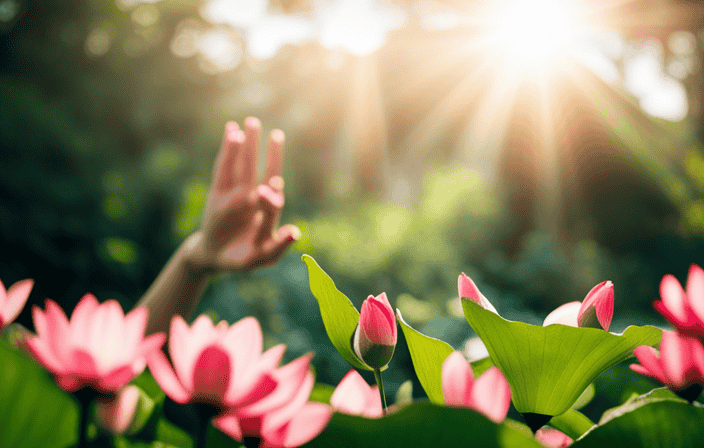
 Spirituality3 months ago
Spirituality3 months agoThe Power Of Spiritual Senses: A Holistic Guide
-

 Aura2 months ago
Aura2 months agoThe Spiritual Meaning Behind Left Eye Twitching
-
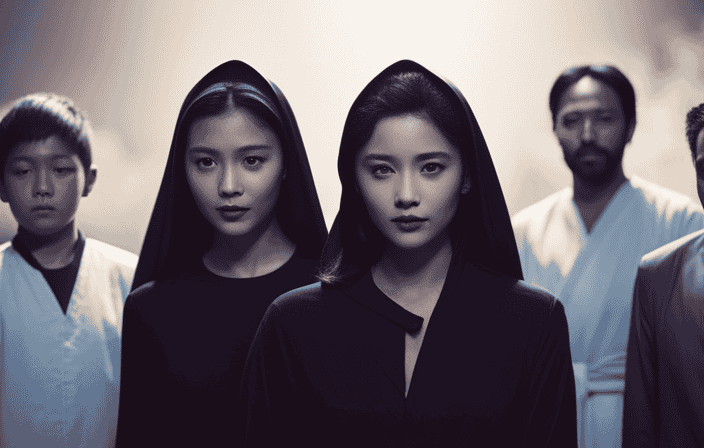
 Inspiration1 month ago
Inspiration1 month agoThe Power Of Spiritual Impartation: Empowering Believers And Cultivating Growth



